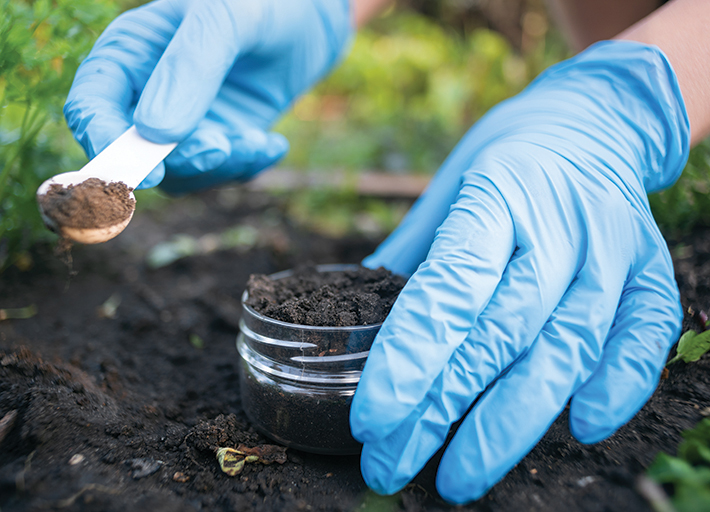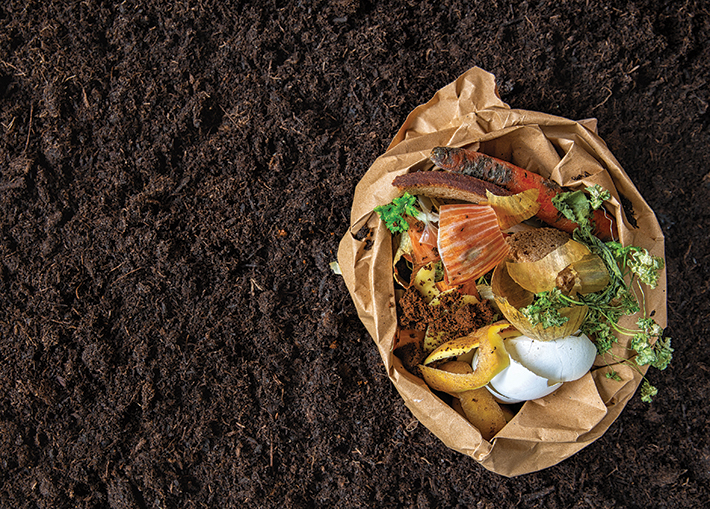
PFAS Remediation in Soil and Biosolids
In recent decades, global awareness of synthetic chemicals like PFAS (per- and polyfluoroalkyl substances) and their impact on humans and animals has grown considerably. Found in everything from personal-care products, food packaging, and nonstick cookware to textiles, cleaners, and firefighting foams, PFAS offer traits such as water repellence, stain resistance, and nonstick surfaces.
However, long-term exposure to PFAS may lead to immune and reproductive disorders, hormonal changes, and developmental delays in children. Studies have shown a plausible link between PFAS and higher cholesterol levels, liver and kidney disease, and an increased risk of some cancers, such as prostate and kidney.
Because these chemicals all contain carbon-fluorine bonds, one of the strongest bonds in organic chemistry, PFAS also possess staying power. Dubbed “forever chemicals,” they degrade very slowly — some may take over 1,000 years to break down according to a January 2021 Scientific American article — giving them plenty of time to bioaccumulate in the environment, wildlife, and people. In 2022, The Guardian reported the presence of PFAS in roughly 20 million acres of U.S. farmland, while a 2023 study by the U.S. Geological Survey noted that 45 percent of Americans’ tap water may contain the chemicals.
FOR YOU: Standards Address PFAS in Everyday Products
Greater knowledge has spurred worldwide efforts to restrict and remediate PFAS. In 2020, the European Union’s environmental treaty, the “Stockholm Convention on Persistent Organic Pollutants,” banned the use of perfluorooctanoic acid (PFOA). It additionally aims to eliminate the use of perfluorooctanesulfonic acid (PFOS). Also in 2020, Japan forbade the manufacturing and use of PFOS and PFOA. Meanwhile, the U.S. Food and Drug Administration (FDA) phased out the use of PFOS and PFOA in 2016. On a state level, Maine outlawed the sale of carpets, rugs, and fabric treatments containing PFAS in 2023, and the sale of all new products containing PFAS by 2030. Other states, including Colorado, Maryland, New York, and Washington, have restricted or prohibited new products with intentionally added PFAS.
But regulations only solve part of the problem. Removing PFAS from the environment is an equally crucial step. Testing has revealed the global presence of PFAS in soil, sewage treatment sludges, and ground, surface, and drinking water. They likewise exist in the air.
Identifying PFAS in Soil and Biosolids
To aid with PFAS remediation efforts for soil and biosolids, ASTM International’s committee on waste management (D34) has published several PFAS-related standards. In late 2023, the committee released the standard test method for determination of per- and polyfluoroalkyl substances (PFAS) in soil/biosolid matrices by solvent extraction, filtering, and followed by liquid chromatography tandem mass spectrometry (D8535). To minimize the use of solvents and consumables, the chemicals are extracted with basic water and methanol, making the extraction simpler, less expensive, and favorable for mobile lab operations and quicker turnarounds. The chemicals are then separated using liquid chromatography (LC) and detected using tandem mass spectrometry (MS-MS), which is extremely specific and experiences little matrix interference. For high-concentration samples, high-resolution MS can be used for further qualitative identification of analytes.
The test method analyzes for PFAS in soil and biosolids — semi-solid to solid, organic, nutrient-rich material recovered from sewage-treatment processes frequently used as fertilizer or mulch — but not in compost or soil additives. It is an updated version of the standard test method for determination of polyfluorinated compounds in soil by liquid chromatography tandem mass spectrometry (D7968), which was developed by the U.S. Environmental Protection Agency’s (EPA) region 5 Chicago regional laboratory.
Although soil contamination can occur almost anywhere, PFAS is especially prevalent in the soil at firefighting-training sites, landfills, and at farms, parks, and other areas where biosolids have been applied.
“We’ve had 30 to 50 years of land-applied biosolids. If you go out and test the soil at a farm, it probably will contain PFAS if they’ve applied biosolids,” says William Lipps, a member of D34 and former chair of the water committee (D19). “It wasn’t as though people were intentionally polluting. It wasn’t illegal to apply biosolids. For the longest time, applying biosolids was considered the thing to do.”
Digging into Compost
Presently, the waste management committee is working on the new test method for determining the degree of disintegration of items under defined in-field composting conditions (WK80528). The work item provides a means of determining whether an item will break down in the real world as well as in lab settings. It will not replace existing test methods in the composting specifications.
Committee member Brian Schumacher says that D34 is considering the requirements to destroy or sequester contaminants in compost. PFAS have been detected in food waste, compostable food packaging, yard waste, and biosolids, and in the compost produced from a mixture of these items. However, composting facilities may not be aware that their feedstocks contain PFAS or other unwanted chemicals.

Standards will support the remediation of PFAS in soil used for composting.
The goal of the new test method, Schumacher says, is to make contaminated compost safe for use in yards, gardens, farms, or fields. The test method would not directly address PFAS.
“Without a standardized field test method, it’s nearly impossible to make sense of results from composting field tests being performed today, primarily due to variation in operating conditions at composting facilities,” says Rhodes Yespen, executive director of BPI and technical contact
for WK80528.
While a significant amount has been written about how to sample materials, far less exists about the equipment needed to properly collect them. The committee’s standard guide for the selection of sampling equipment for waste and contaminated media data collection activities (D6232) alleviates this dearth. The guide lists the equipment suitable for gathering samples from soil, sediment, and water in waste-management settings. Among other tools, it discusses augers, pumps, bailers, tubes, scoops, spoons, shovels, and dredges. As stated in the standard, the guide “details its applicability for use based on compatibility of sample and equipment; volume of the sample required; physical requirements such as power, size, and weight; ease of operation and decontamination; and whether it is reusable or disposable.” The advantages and disadvantages of each tool and considerations in their selection, such as choosing fluorine-free materials for PFAS sampling, appear in the standard. The guide should minimize the likelihood of inaccurate results.
Cooperation within ASTM and with the EPA
When creating PFAS remediation standards for soil, the waste management committee utilizes the expertise not only of its own members but also of those in other committees. Soil and rock (D18), water (D19), air quality (D22), and environmental assessment, risk management, and corrective action (E50) have all collaborated with the waste management group on complementary standards.
An example of these concerted efforts is the water committee’s standard test method for determination of PFAS in aqueous matrices by co-solvation followed by liquid chromatography tandem mass spectrometry (D8421), to which members of D34 devoted their time and expertise. The water committee’s test method is similar to the method found in waste management’s D8535. Both standards enable laboratories to use the same instrument with the same chromatography method for water and soil samples.
READ MORE: The Fight Against PFAS
Lipps elaborates on how the concerns of the water and waste-management committees overlap. “If biosolids have been applied to soil, PFAS may leach out and get into the water supply. Additionally, PFAS is in many of our consumer products and, when those products go to an unlined landfill, PFAS could get into the ground water. If that contaminated water is used for irrigation or other purposes, PFAS could then get into the soil,” he says.
The committee’s working relationships extend beyond ASTM to include the EPA and its Resource Recovery and Conservation Act (RCRA). Enacted in 1976, RCRA is the main federal law on transportation, treatment, storage, and disposal of solid and hazardous waste in the U.S. It is implemented by the EPA’s Office of Resource Conservation and Recovery (ORCR), which has a cooperative agreement with ASTM. ORCR and D34 members meet four times a year to discuss waste-management standards.
“We [D34] helped the EPA develop standards for SW-846, which is the bible for how to sample and analyze waste,” says former EPA enforcement officer, quality manager, and longtime D34 member Kenna Yarbrough. “Many of the D34 standards were written to address the requirements of SW-846. We had direct funding from the EPA and assisted in writing this huge compendium that is still in use today.”
Published in 1980, SW-846, the Hazardous Waste Test Methods manual, is in its third edition. The waste management committee’s standards appear in Chapter 9 (“Sampling Plans”) of SW-846.
“The goal was that whatever standards we produce get built into SW-846,” says Schumacher. “In the 1990s, we sped up that process to get these documents out there, putting in 30 or so standards so that the EPA could cite them, by reference, in their sampling chapter of SW-846. As new things come along, we have to shift. Right now, PFAS is more on the analytical or methods side of it rather than on the sampling side. If there’s PFAS in waste and it’s been spilled, that’s where we need PFAS determinations.”
Challenges and Considerations in PFAS Remediation
Contaminants as pervasive and persistent as PFAS present certain challenges when creating remediation standards. The sheer number of chemicals categorized as PFAS is one issue. The EPA’s CompTox Chemicals Dashboard cites 14,735 chemicals in this group, all of which possess different properties.
Problems can also arise with cross-contamination at sampling sites. Consumer goods found at or brought into a site may contribute PFAS to a field sample and skew the test results.
Another consideration is the low concentration of permissible PFAS, which makes their detection trickier. In 2022, the EPA released an interim, updated drinking water health advisory for PFOS, PFOA, PFBS, and Gen-X chemicals. These chemicals are all categorized as PFAS. The maximum level for PFOS in drinking water was reduced to 0.004 parts per trillion (ppt) while PFOA was changed to 0.02 ppt. The EPA has not released an advisory for PFAS in soil and biosolids.
“With PFAS, we’re moving toward a sticky issue,” says Yarbrough. “How do we sample and analyze when we’re looking for parts per billion and trillion? They’re at such low levels but these very low levels are dangerous to human health and the environment. Plus, there are thousands of the compounds and we don’t know what most are yet. It’s an extremely complex issue.” She adds, “With the partnership between the EPA and D34, we are able to come up with new sampling and analytical standards that will be helpful in the future and will standardize, to the best of our ability, a waste stream that is largely unknown.”
For additional information about committee D34 and standards for PFAS remediation in soil and biosolids, please contact staff manager Brian Milewski at b.milewski@astm.org. ■
Kathy Hunt is a U.S. East Coast-based journalist.
 SN Home
SN Home Archive
Archive Advertisers
Advertisers Masthead
Masthead RateCard
RateCard Subscribe
Subscribe Email Editor
Email Editor